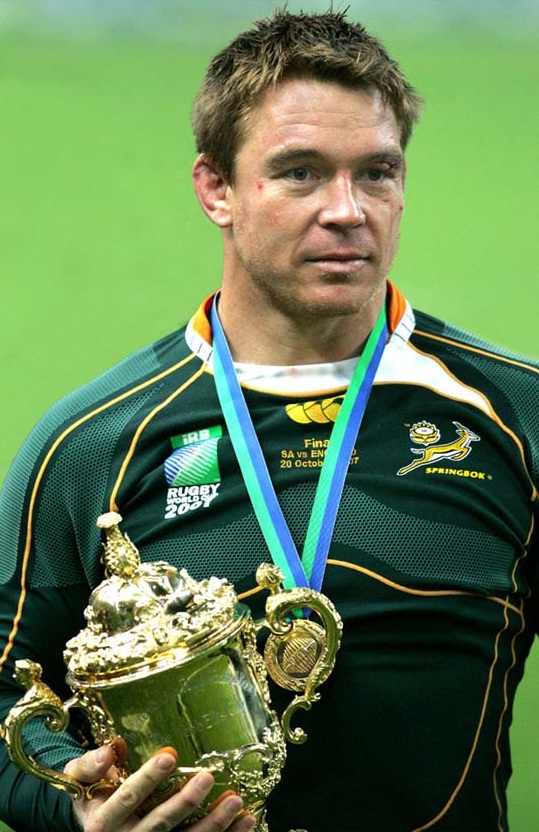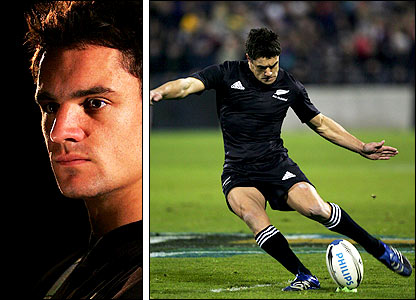The guide for those very new to the game, this guide just outlines the very basics of rugby including:
- The players.
- How the game go's.
- Scoring system.
- The pitch.
- Set plays (scrums, lineouts).
- Rucks and Mauls.
Players:
 |
| can you guess where he plays? i'll help you, he's a forward. |
There are 15 players on the pitch from each team, that splits into 8 forwards and 7 backs; to put it simply the forwards are the big ugly one's who do the hard jobs in order to get the balls for the backs so they can do there job - the fancy, try scoring stuff.
Obviously there's lots more to it than that but as you play and watch the game you'll understand more and more of it.
How the game goes:
The game always starts with a kick off- which team kicks is determined by the flip of a coin-, the kick always has to be a drop kick (dropping the ball and kicking it while it bounces) and is kicked towards the opposition. After every try the same thing happens.
The attacking team are trying to break the opposing teams line and make there way up the pitch towards there try line so they can score (see below).
The defending team are trying to
tackle the opposition to stop them getting to there try line, when a player is tackled
a ruck is formed (see below or link), here both teams compete for the ball and this is an opportunity to win possession of the ball but often the attacking team wins.
If you can't win the ball in rucks you have to wait for there team to make a mistake e.g. knock on the ball, give away a penalty etc..
Scoring:
The scoring system in rugby is quite simple, here's how it goes:

- A try (scored by placing the ball down between try line and dead ball line, see below- under pitch) = 5 points.
- Once a try is scored, team have opportunity to kick the ball over the post (called a conversion), if the ball goes through the posts = 2 points
- If a penalty is given, team can choose to go for a conversion, if the ball goes through the posts = 3 points
- The last way to score point is to drop kick (dropping the ball on the ground and kicking it as it bounces) which is used in open play and if successful = 3 points
The pitch.
A pitch is supposed to be 100m long but often clubs and schools don't always have the space to offer this but the boundries are always labeled the same to avoid confusion.
On the right below, is a labeled diagram of a rugby pitch, i'll start from the top label going downwards:
 |
| A rugby pitch with labeled boundries |
-
The dead ball line is a line that if at anytime the ball goes past play stops and either starts with a 22 meter drop out- basically a kick from the defending team inside the 22m line- which happens when the attacking team kicks it over or runs over the dead ball line, if the ball is taken over the dead ball line by the defending team, for whatever reason its a 5 meter scrum to the attacking team;
the five meter line isn't shown but its just 5 meters away from the try line.
-
The try line is the line
, in which both teams are attempting to get over in order to score points, if you get over the opposing teams try line and place the ball down between there and the dead ball line you score.
-
The 22 meter line i have already talked about the 22m drop kicks when the opposing team takes the ball over your dead ball line but its also a line marked out in which, when inside of it, you can kick the ball straight into touch, normally when you kick the ball in to touch without it bouncing then a lineout is taken from where the ball is kicked from instead of where the ball goes out.
-
The 10 meter line is marked out because when the match starts or a team score's there is a drop kick to start/restart the match and the ball must travel past this line.
-
The halfway line is where the ball is kicked from on a start/restart and simply marks halfway.
If you were confused by anything in this section like the lineouts then don't worry, it will all be answered later.
Set Plays.
Set plays mainly happen either when the ball is kicked out of play (past the sideline boundaries), when it is knocked on forward or when it is passed forward.
There are two set play's: the scrum and the line out and i'll describe both of them in detail below, the same set up is used every time but different out comes always occur as both teams have the ability to compete for the ball.
Scrums-
Scrums is one form of set play and occurs when a player from either team knocks the ball forward (drops the ball) or passes the ball forward.

The scrum is made up of 8 payers:
Prop (1) Hooker (2),
Props (3),
Flanker (6) Second row(4) Second row (5) Flanker (7)
Number 8 (8)
Every player has there specific roll in the scrum and by clicking on the links above you will go to there specific guides and what they do in the scrum.
In the scrum the 3 front rows (props and hookers) will bind up together in there own way e.g. grabbing shirts, shorts etc.. and then once both packs are formed the ref will say crouch - everyone crouches- ... touch - props touch each other to show there correct distance away-... pause - everyone is anticipating contact- and ENGAGE! The two massive forces collide and push to win the ball.
Now once they have engaged the scrumhalf puts the ball in- the team putting the ball in the scrum have the advantage because the scrumhalf can tap there teams hooker to tell him the balls coming in so hes ready to strike, also often the scrum half feeds the ball to his team meaning he drops it so it bounces towards there side, i should mention this is illegal.
I mentioned the Hooker above, and once the ball is put in he has a very important part to play. His aim is to Hook the ball back towards his side (hooking is just hitting the ball back with his feet) but he has to battle it out with the opposite hooker, its very technical and often the one with the fastest feet and the best strike wins.
Line outs:
 |
| line out in rugby |
Line outs happen when the ball is carried or kicked to touch, the team who take or kick the ball into touch lose possession and its the other teams throw.
What happens is the 8 forwards lineup, one behind each other, so there are two lines of players, 1 from each team, 1 meter or so away from each other, once in position the team throwing in the ball call out a secret code communicating where the hooker, once again playing a major role, throws the ball to.
The ball has to go straight down the middle of the two lines and the two players from each team lift a player in the air (holding him by his legs) in order to catch the ball.
Rucks and Mauls:
These two things are major parts of the game - especially the rucks.
Ruck:

A ruck is formed when a player is tackled, he places the ball back towards his side - he can then not move it or do anything with it on the floor or its a penalty- and players (usually forwards) from both side step over the player trying to ruck (basically rucking is pushing, although not best done with hands and arms but instead shoulders and using the power of your legs) each other of the ball.
Once again these players rucking over the ball are not aloud to touch it with there hands and instead have to push over it so the
scrumhalf can get it out and pass it


























